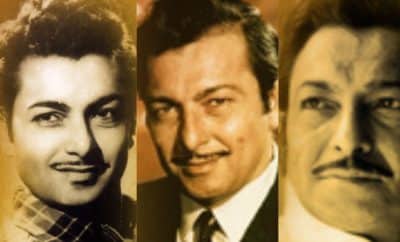Song Sketch
Jeena Issi Ka Naam Hai – The Song that Depicts the Principles of Humanism and Reveals the Real Meaning of Life
In Indian film industry there was an era when lyricists used to deliver rich thoughts and principles through their songs. Kavi Shailendra was prominent among them. Kisi Ki Muskurahaton Pe Ho Nisar from Anari (1959) is a classic example of his simple but immortal words. It speaks about the richness of mind which cannot be counted in terms of money. Now, it is interesting to see how intelligently the message of Kavi Shailendra is reflected in the music of Shankar-Jaikishan and the direction of Hrishikesh Mukherjee. Before going to the actual song let us take a look at the background of the song in the film.
Raj Kumar (Raj Kapoor) a common man receives Rs. 1,000/- as honorarium for his art work. For a poor man like him Rs. 1,000/- stands a big amount. However, he gives away all the money to Aarti (Nutan). He is under impression that Aarti is a poor girl like him and needs money for medical treatment of her mother. Raj leaves her home with utmost satisfaction and the song begins.
Nothing in life is more joyful than being helpful to a needy person. You can see this joy on his (Raj) face. Also, exactly the same mood reflects through the starting violin piece followed by an accordion piece. When you give everything that you have; you feel like a free bird. Here you can see the birds flying in the sky. Then comes the guitar piece, which makes a perfect harmony with Raj’s footsteps. Then Raj goes ahead and overtakes a flock of sheep. Here I think Hrishida wants to show Raj’s uniqueness against others who used to follow the routine path like sheep.
In the military, the band and route march are used to keep the will of soldiers at high level. Considering the excitement of Raj, Hrishida has intelligently shown some scout boys performing the route march and also the excellent drum piece by music directors Shankar-Jaikishan. Then Raj also begins marching to the rhythm of drums. When a man is at heightened level of excitement, he is rarely aware of what he treads on. But, here again Hrishida has showed the distinct flair of Raj. Although he is marching most passionately he is aware of a small insect moving across the road. Suddenly he stops; the music also stops for a second. Then on the background of a beautiful music piece of guitar he gently picks up the insect on a leaf and drops him on a nearby bush. Then begin the immortal words – Kisi Ki Muskurahaton Pe Ho Nisar
Raj is not afraid of his poverty. He is a rich man by heart. He believes that the real life is one which is lived for others’ happiness
Mite Jo Pyar Ke Liye Wo Zindagi, Jale Bahar Ke Liye Wo Zindagi
At the beginning of the second stanza he saves a blind beggar from colliding with a man rapidly passing across. Lastly, with the words
Ke Mar Ke Bhi Kisiko Yaad Aayenge, Kisi Ki Ansuon Mein Muskurayenge
He even gives away the chanas received from the small vendor to the blind and proceeds happily on his way. What is the simplest way for a common man to express his feelings through music? Yes, it is whistling. The song ends with Raj whistling and disappearing in the evening shadow.
In my opinion, this song sets a landmark example of how the message given in the song is to be carried effectively through music and film direction. No doubt words have great strength of their own. But, their reach is limited as compared to music. When words are converted into a songs and a song is presented through a film, its effectiveness increases exponentially. So, it is a great kind of teamwork performed by the lyricist, the music director, the film director, the actor, etc.
I salute all those great artists for showing us the real way of life. As rightly said by Kavi Shailendra, the message given in the song is timeless in nature and will be propagated from generation to generation Kahega Phool Har Kali Se Bar Bar, Jeena Isi Ka Naam Hai



